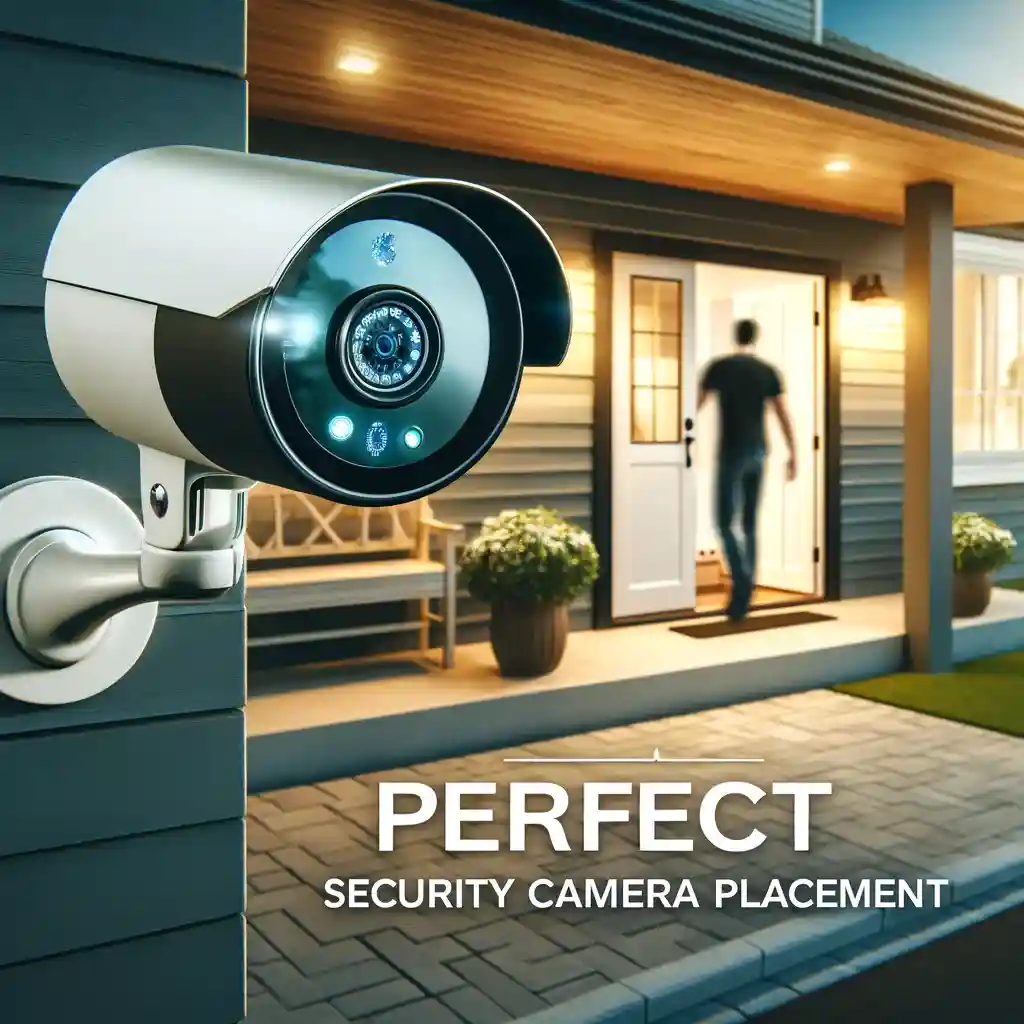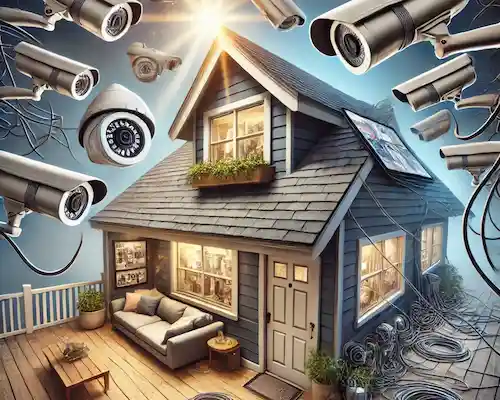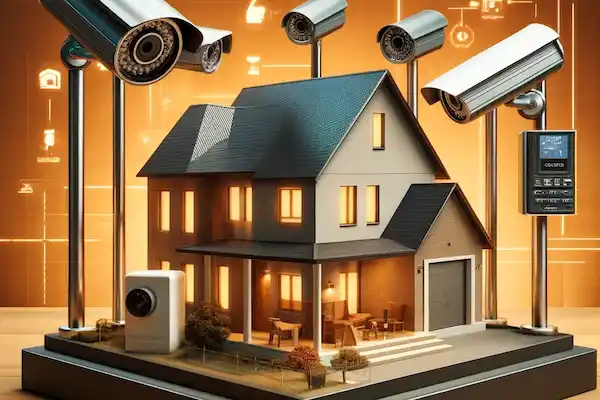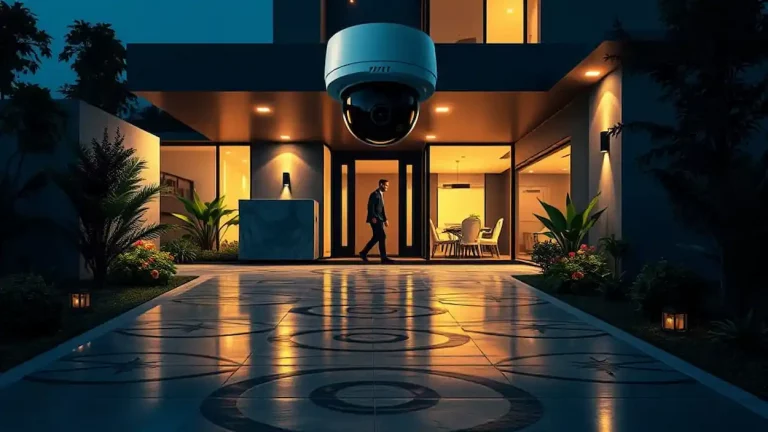Did you know that homes without security cameras are 300% more likely to be broken into? Installing security cameras is a smart move, but placing them in the wrong spots can make them completely useless.
I once had a friend, Mike, who thought he had the perfect setup—cameras covering his front yard and backyard. Then, one night, someone broke into his car. His footage? A perfect view of the top of the thief’s head. Not helpful at all!
So, let’s make sure you don’t make the same mistakes. In this guide, I’ll walk you through the best and worst places to install security cameras and give you expert tips to keep your home safe.
The Biggest Mistake? Placing Cameras in the Wrong Spots!
Have you ever watched security footage where the burglar’s face is either completely blurred, hidden in shadows, or out of frame? That’s what happens when you install your cameras without a strategy. Here are some common placement mistakes:
- Mounting cameras too high or too low – You need a clear view of faces and license plates, not just blurry figures.
- Ignoring blind spots – Many homeowners forget to check what their cameras actually see.
- Pointing directly at bright lights – Sunlight or streetlights can wash out footage.
- Focusing only on the front door – While it’s important, it’s not the only entry point thieves use.
Let’s talk about the best places to install your security cameras.
Best Places to Install Security Cameras (Expert-Recommended)

1. Front Door – Your First Line of Defense
More than 34% of burglars enter through the front door. That’s right—many thieves just walk right up as if they own the place. A well-placed camera will catch them before they even get inside.
🔹 Placement Tip: Mount the camera at eye level (about 5-7 feet high) and angle it downward. If you place it too high, you’ll get a nice shot of their hat, not their face.
🔹 Pro Tip: Use a video doorbell camera—these are harder to tamper with and provide two-way audio.
2. Back Door – The Most Overlooked Entry Point
The back door is burglar gold because many homeowners don’t think to secure it.
🔹 Placement Tip: Position the camera directly above or next to the door, so it captures the full frame of anyone approaching.
🔹 Pro Tip: Choose a camera with motion detection and night vision to catch sneaky nighttime visitors.
3. Garage & Driveway – Where Your Valuables Are
Your garage is a jackpot for thieves—bikes, tools, even cars! And don’t forget your driveway; cars are one of the most stolen items from homes.
🔹 Placement Tip: Angle the camera so it covers both the garage entrance and the driveway.
🔹 Pro Tip: Use a floodlight camera to startle intruders and improve nighttime visibility.
4. Side & Basement Doors – Weak Entry Points
Side doors and basement entrances are hidden, making them a favorite entry point for burglars.
🔹 Placement Tip: Install cameras at a slight downward angle to avoid missing key details.
🔹 Pro Tip: Pair your cameras with motion sensor lights for extra security.
5. First-Floor Windows – A Common Entry Method
Unlocked windows are an easy way in, especially on the first floor. Even locked windows can be pried open!
🔹 Placement Tip: Install cameras on exterior walls facing the windows.
🔹 Pro Tip: Set up motion alerts so you get notified when someone lingers near your windows.
Worst Places to Install Security Cameras (Avoid These Traps!)

1. Inside Bedrooms – Major Privacy Risk
Sure, you want security, but placing cameras inside bedrooms can invade privacy and make people uncomfortable.
2. Facing Direct Sunlight – Blurry, Useless Footage
If your camera is pointed directly at the sun, the footage will be overexposed and unusable. Always test the lighting at different times of day.
3. Too High or Too Low – The Wrong Angles
Placing cameras too high captures only tops of heads. Placing them too low means someone can easily tamper with them. 5-7 feet is the sweet spot.
Pro Tips for Maximizing Your Security Camera’s Effectiveness

1. Use Motion-Activated Alerts
There’s no point in having cameras if you’re not actively monitoring alerts. Set up notifications to instantly know when someone approaches your home. This ensures you stay informed without constantly checking your cameras. But don’t just rely on static footage—motion detection adds another layer of security. It can notify you immediately when something moves in your yard, which is perfect for catching potential intruders before they get too close.
If you’re interested in optimizing your home’s security even more, check out our motion detection camera guide to learn how these advanced systems can work alongside your current setup!
2. Connect to Smart Home Systems
Link your cameras to smart locks and lights so you can remotely lock doors and turn on floodlights. This not only enhances convenience but also improves your home’s security by giving you full control, even when you’re not at home. By integrating your security cameras with a broader smart home system, you can automate various aspects of your home security.
For a deeper dive into security and surveillance options, visit our Security & Surveillance category to find the best products and solutions for a fully integrated smart home experience!
3. Secure Your Cameras from Hackers
Hackers love unsecured cameras. Here’s how to keep yours safe:
- Change default passwords immediately.
- Enable two-factor authentication.
- Update firmware regularly.
Explore our guide on the top features of a reliable security camera and the best DIY home security systems to fortify your home against hackers and intruders.
4. Use Night Vision & Floodlight Cameras
A camera that doesn’t work at night is practically useless. Invest in cameras with infrared night vision or built-in floodlights.
Final Thoughts: Are Your Cameras in the Right Places?
Security cameras are only as good as their placement. Take a walk around your home and use this checklist:
✔️ Front & back doors covered?
✔️ Garage and driveway monitored?
✔️ No blind spots or wasted views?
✔️ Motion alerts set up?
If you can say yes to these, your home is much safer than before. If not, now’s the time to fix it!
FAQs
1. How many security cameras do I really need?
It depends on your home size, but 4-6 cameras usually cover the main areas (front door, back door, garage, and main entry points).
2. Can I install security cameras myself, or do I need a professional?
Many modern cameras are DIY-friendly. If you’re unsure, pros can optimize placement for best results.
3. What’s the best height for mounting a security camera?
The sweet spot is 5-7 feet high for the best angle without being tampered with.
4. Do I need cameras inside my house?
Not necessarily. Focus on entry points first. Indoors, use smart sensors instead of cameras for privacy.
5. What’s the best security camera for night vision?
Look for infrared night vision or floodlight cameras for clear images in the dark.


This Post Has 24 Comments
https://vitz.ru/forums/index.php?autocom=gallery&req=si&img=4809
Pingback: viagra sildenafil 50mg
Pingback: clomid buy online
Pingback: maxifort sildenafil 100mg
Pingback: cialis 10mg price
Pingback: cialis discount
Pingback: sildenafil tab 25mg
Pingback: ginseng root morning routine for men
Pingback: high point pharmacy sildenafil $75
Pingback: cialis 10mg price
Pingback: cialis generic cost
Pingback: how much does cialis cost
Pingback: cialis cost
Pingback: viagra 50 mg coupon
4ac2fs
e0s9bu
oqfglb
vs03dy
Thanks for the auspicious writeup. It if truth be told was a enjoyment account it. Glance complex to more introduced agreeable from you! However, how could we be in contact?
Chỉ sau thời gian ngắn ra mắt, xn88 win đã nhanh chóng khẳng định vị thế tại thị trường quốc tế với sự hiện diện tại hơn 20 quốc gia, nổi bật tại châu Á như Việt Nam, Thái Lan, Nhật Bản và đang mở rộng sang châu Âu.
888slot có lừa đảo không Hiện nay, nền tảng cung cấp đa dạng hình thức giải trí khác nhau để phù hợp với mọi nhu cầu của anh em. Ngoài việc được tham gia vào các danh mục truyền thống như Casino, Thể Thao, Nổ Hũ thì bạn còn được khám phá nhiều loại hình đặc sắc mới như Đá Gà, Bắn Cá.
I have been absent for some time, but now I remember why I used to love this blog. Thank you, I¦ll try and check back more frequently. How frequently you update your site?
Tính công bằng tại đăng nhập 188v được đảm bảo thông qua hai cơ chế chính: hệ thống RNG đã chứng nhận và chính sách minh bạch thông tin. Mọi tỷ lệ trả thưởng (RTP) đều được công khai và được kiểm toán định kỳ bởi các đơn vị độc lập.
Không phải ngẫu nhiên mà slot365 login lại chiếm được lòng tin của nhiều người chơi đến vậy, để làm được điều này nhà cái đã không ngừng nỗ lực và cải thiện chất lượng dịch vụ của mình để mang lại những thứ tốt nhất dành cho người chơi.